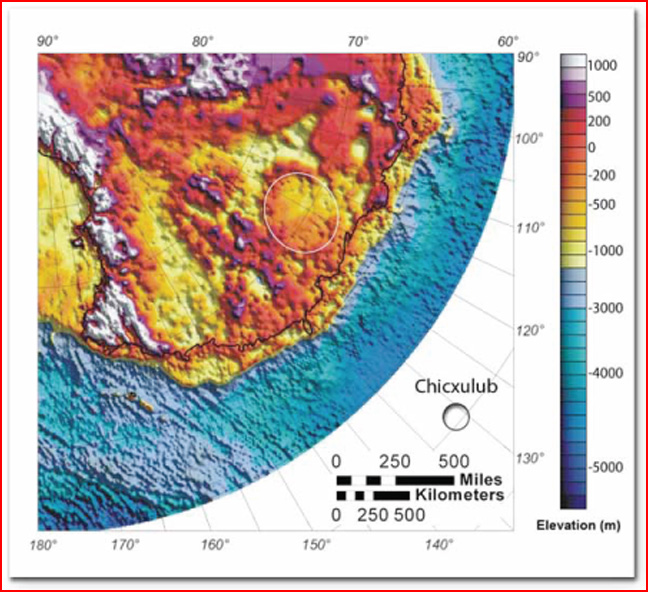
home •
about •
essential guide •
picture of the day •
thunderblogs •
news •
multimedia •
predictions •
products •
get involved •
contact
picture of the day archive subject index
The Wilkes crater site compared to the Chicxulub crater. Image Credit: Ohio State UniversityNov 28, 2007
Antarctica: Fire and Ice
A large crater has recently been discovered underneath the ice of Antarctica, sparking theories of an asteroid impact. Could there have been electrical forces involved as well?The word "Antarctica" comes from the Greek, antarktikos and means "opposite the Arctic." It has a total land area of almost 14.5 million square kilometers, making it the third smallest continent after Europe and Australia. It currently ranks as the coldest place on Earth with the highest average winds. Because rainfall only occurs along the coast, it is also the world's largest desert.
Nearly the entire continent is covered in ice, so finding structures hidden underneath it has been impossible until the development of ground-penetrating radar technology such as the Mass Concentration Gravity Recovery and Climate Experiment (GRACE). With it, Ohio State University scientists have been able to see many formations, including a crater measuring 483 kilometers wide. As the gravity map shown above indicates, the Wilkes Land crater is twice as large as the Chicxulub crater in Mexico, which is thought to be responsible for the extinction of the dinosaurs 65 million years ago. The Wilkes Land crater is estimated to be 250 million years old and along with a 200-kilometer diameter crater called Bedout off the Australian coast is theorized to have caused the greatest die-off of all time, the Permian extinction.
The extinction of flora and fauna over a large area will always be a mystery regardless of what theory is used to create experiments or to explain evidence. But supposing the impact of a space rock to be the causative event in each situation relies too heavily on coincidence. Massive die-offs, ice ages, speciation and geological features are all attributed to meteors and asteroids by modern convention. One might ask what space-borne stones cannot do.
In a previous Thunderbolts Picture of the Day, we analyzed the problems associated with asteroid impacts including the so-called "extinction" evidence. In particular, the Chicxulub crater was attributed to something other than an asteroid:
"The electrical origin of the Chicxulub crater and surrounding geology resolves all of the contradictions in the evidence.... The primary crater-producing discharge could have excised the rock inside the crater and left a central peak without shattering the underlying rock. The electrical current, lasting longer than the forces of an impact, would have melted large amounts of material and formed vast clouds of spherules, a key signature of electrical discharge."
Under the standard model, Antarctica has been frozen since the last ice age, almost 30,000 years ago. But the various anomalies like the youthful age of the glacial debris and the charred forests that lie buried under the ice speak of a cataclysm that might have been caused by a tremendous electric discharge. The electrical forces that were unleashed may have actually caused the continent to freeze, the forests to burn and the animals to die and become fossilized in a short period of time.
If catastrophes that could electrically machine a 483-kilometer crater into the Antarctic continent have occurred, then radioactive decay rates could have changed. If plasma discharge phenomena actually jumped to Earth from an encounter with an unknown object, the isotope ratios could also have changed. There are no "clocks" left intact by which we can establish when the encounter took place, so making claims of an extinction at a certain time is untenable. The best we can do is to say that the evidence points to electric arcs as the causative agent for the Antarctic crater. Perhaps the future will bring discoveries that will enable us to establish timelines and dates, but that time is not now.
By Stephen Smith
___________________________________________________________________________Please visit our Forum
The Electric Sky and The Electric Universe available now!

|
|

|
EXECUTIVE EDITORS:
David Talbott, Wallace Thornhill
MANAGING EDITORS:
Steve Smith, Mel Acheson
CONTRIBUTING EDITORS: Michael Armstrong, Dwardu Cardona,
Ev Cochrane,
C.J. Ransom, Don Scott, Rens van der Sluijs, Ian Tresman
WEBMASTER: Brian Talbott
Copyright 2007: thunderbolts.info
![]()
home •
thunderblogs •
forum •
picture of the day •
resources •
team •
updates •
contact us

